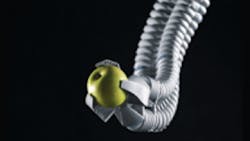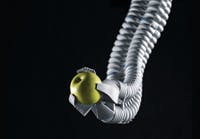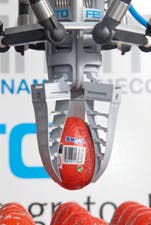Servopneumatics lets robot mimic nature
The Bionic Learning Network at Festo AG, Esslingen, Germany, is a think-tank of researchers using nature as a role model to develop new machines and motion systems. One recent development is the Bionic Handling Assistant, a lightweight, biomechatronic robot that relies on servopneumatics to produce motion much like that of an elephant’s trunk. Some day it could change the way manufacturers handle products.
It consists of three basic elements: an arm, hand axis, and gripper with adaptive fingers. The arm is made up of three segments, each comprised of three polyamide bellows actuators with a 3° taper running the length of the segment. Individual bellows cover about a third of the arm’s circumference, so actuating all three with compressed air linearly extends the arm. Pressurizing just one or two produces angular displacement. The bellows act like a spring and return to their original position when compressed air exhausts. Bowden cable potentiometers mounted outside the actuators track position and permit closed-loop control of movements.
The hand axis contains three additional bellows actuators surrounding a ball joint. Activating them displaces the gripper by angles up to 30°. Festo SMAT-8M position transmitters — compact, magnetic-proximity sensors with ±0.1 mm repeatability — track movements and make for precise alignment.
Finally, the FinGripper, with a design based on a fish’s tail fin, is what actually grasps the workpiece. Unlike conventional metal grippers handlers, the FinGripper is light, flexible, and readily adapts to an object’s shape, which makes it particularly well-suited for fragile and irregularly shaped products. It consists of a pneumatic bellows actuator (or, for longer life, a simple pneumatic cylinder) and three fingers. Compressed air actuates the bellows which, via lever action, open and close the fingers.
The basic finger consists of two plastic bands which meet at one end to form a triangular structure. Intermediate stays that add strength connect to the bands via articulated joints. This flexible design lets the fingers adapt to the shape of a workpiece when pressure is applied laterally — just like a human hand, but much faster, according to company officials.
Festo’s VPWP proportional directional control valves control flow to the actuators in the servopneumatic system. The valves have 5/3-way operation for varying the direction and speed of movement and feature digital data transmission, built-in pressure sensors, an adaptive, “self-tuning” control algorithm, and diagnostic capabilities.
Overall motion control is via the CMXR robot controller that is also used with the company’s tripod handling robots and high-speed gantries. The CMXR, according to company officials, combines mechanical, drive, and control elements into a complete kinematic system that coordinates highly dynamic 3D motion.
It offers such features as motion-path smoothing, ramp shapes for acceleration, and constant path speeds, but it also protects the handling device — say from overloads. CMXR interpolates and positions all axes, so it can define the tooling end position in three dimensions. This means it can trace contours along a centerline, as is required for bonding, laser welding, and water-jet cutting. The CMXR is the interface to the master controllers, as well as to valve terminals, servo-axis motor controllers, and vision systems.
Unconventional manufacturing
A particular challenge for Festo’s engineers was how to efficiently manufacture the precise geometric structure of the pneumatic actuators and grippers. And, in fact, “this completely new handling concept is only made possible by rapid manufacturing technology,” explains Klaus Mller-Lohmeier, Manager of Advanced Prototyping Technology at Festo. The components were all made by a selective laser sintering process. “Otherwise, they wouldn’t be practical to fabricate,” he explains.
In this process, successive layers of polyamide powder just 0.1 mm thick are applied onto a base platform. Each new layer is fused to the underlying layer by a laser beam, which hardens the powder to form a solid structure. This avoids the expensive molds necessary to produce parts through conventional injection molding.
The high flexibility, excellent long-term resilience, and low density (0.95 gm/cc) of polyamide make it well suited for the Bionic Handling Assistant, says Festo. The material provides an unprecedented ratio of weight-to-force transmission capacity, a prerequisite for the device’s high performance. For instance, the FinGripper weighs about 90% less than comparable metal grippers, letting it hold and transport workpieces efficiently.
The Bionic Handling Assistant is currently only a prototype, undergoing test and evaluation. A third-generation version is due out early next year. However, the underlying design principles lend themselves to future innovations, says Festo. Possible applications extend beyond the automated gripping of delicate objects such as fruit, vegetables, eggs, and plants. Other potential uses, according to the company, include automated dairy operations, handling medical devices, and supporting the elderly and physically handicapped.
The FinGrippers, however, are currently being used on more-conventional tripod robots by nearly 20 users to quickly and reliably handle fruit, flowers and bulbs, and pressure-sensitive food such, as hollow chocolate eggs.
Watch the robot in action now:


